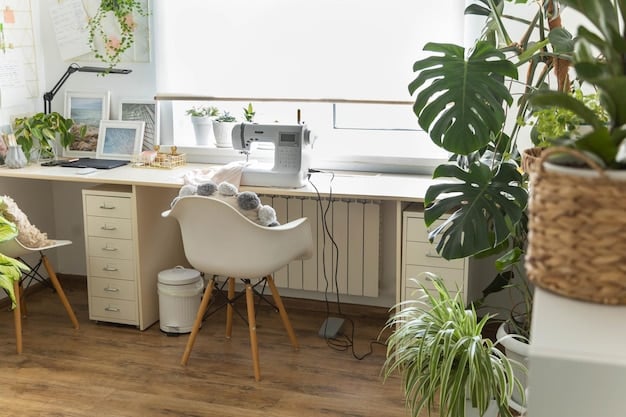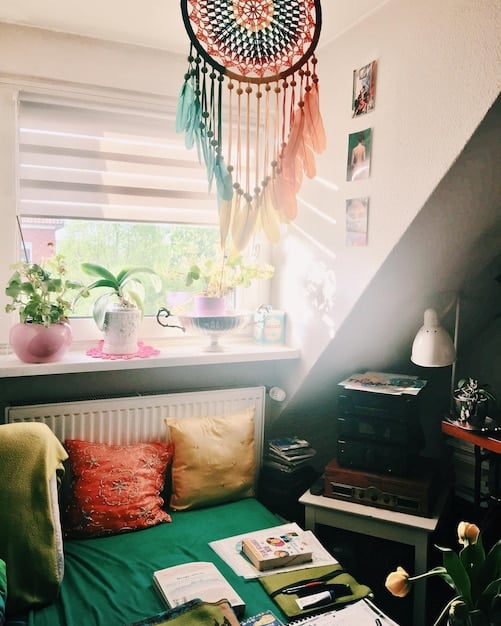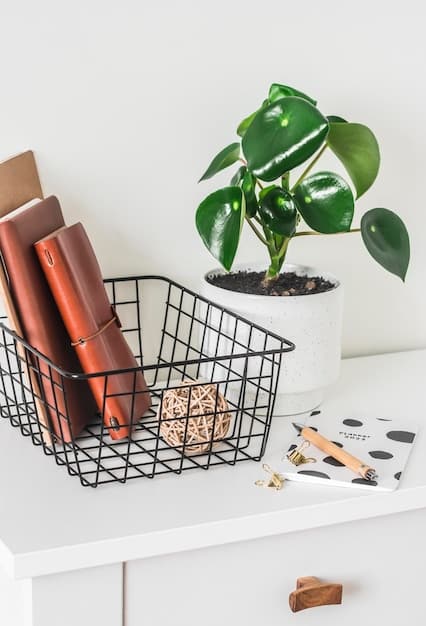Create a Dedicated Workspace: Boost Focus & Efficiency

Creating a dedicated workspace involves optimizing your environment for focus and efficiency by minimizing distractions, organizing your space, and ensuring ergonomic comfort to enhance productivity and work-life balance.
Ready to boost your productivity and reclaim your focus? Discover how to create a dedicated workspace: optimizing your environment for focus and efficiency is the key to achieving a harmonious work-life balance and unlocking your full potential.
Why a Dedicated Workspace Matters
In today’s hybrid work culture, the lines between personal and professional life often blur. Having a dedicated workspace offers a sanctuary, a place solely purposed for work, away from the distractions and comforts of home. This separation is crucial for both productivity and mental well-being.
Creating a dedicated workspace isn’t just about setting up a desk; it’s about crafting an environment that primes your mind for work. It’s about minimizing distractions, promoting focus, and fostering a sense of professionalism, even within the confines of your home.
Increased Productivity
A dedicated workspace significantly boosts productivity. When you have a designated area, your brain associates that space with work, making it easier to transition into a productive mindset.
- Eliminates the need to set up and pack away your work materials each day, saving time and energy.
- Reduces distractions from family, pets, and household chores.
- Promotes better focus and concentration, leading to higher quality work.
Improved Mental Well-being
Separating your work life from your personal life is vital for mental well-being. A dedicated workspace helps to create this separation, reducing stress and preventing burnout.
- Creates a clear boundary between work and personal time, allowing for better relaxation after work hours.
- Minimizes the feeling of being “always on,” which can lead to chronic stress.
- Provides a sense of control and order, which can enhance overall mental well-being.
Having a dedicated workspace is essential to setting boundaries and cultivating a professional mindset, ultimately boosting both productivity and well-being.
Choosing the Right Location
The location of your dedicated workspace can significantly impact your ability to focus and be productive. The ideal location should be quiet, free from distractions, and conducive to concentration. Consider your available space and choose wisely.
Assess your home for potential workspace areas that meet these criteria. It could be a spare bedroom, a corner in the living room, or even a repurposed closet. The key is to find a space that can be transformed into a zone dedicated solely to work.

Spare Bedroom
If you have a spare bedroom, it can be an ideal location for a dedicated workspace. A separate room offers privacy and minimizes distractions, allowing you to fully concentrate on your work.
- Provides ample space for a desk, chair, and storage.
- Can be closed off to minimize noise and interruptions.
- Offers the opportunity to create a fully customized and professional environment.
Corner of a Room
If a spare bedroom isn’t available, consider designating a corner of a room as your workspace. This can be achieved in a living room, dining room, or even a large bedroom. The key is to create a visual separation between your work area and the rest of the room.
- Utilize screens, bookshelves, or curtains to create a physical barrier.
- Arrange your desk and chair in a way that faces away from distractions.
- Use rugs or different flooring to define the workspace.
Finding the right location sets the foundation for a successful and productive workspace. Consider your needs, available space, and personal preferences when choosing your spot.
Essential Furniture and Equipment
Selecting the right furniture and equipment is vital for creating a comfortable and efficient workspace. Ergonomic design should be your top priority to prevent physical strain and promote well-being. Invest in quality items that will support your posture and overall health.
Consider a standing desk, an ergonomic chair, and a monitor stand to ensure a comfortable and productive work environment. These investments can significantly reduce back pain, neck strain, and eye fatigue.
Ergonomic Chair
An ergonomic chair is an essential piece of furniture for any dedicated workspace. A good chair will support your back, promote proper posture, and reduce the risk of developing musculoskeletal issues.
- Look for chairs with adjustable height, lumbar support, and armrests.
- Choose a chair with breathable fabric to prevent overheating.
- Ensure the chair allows you to sit with your feet flat on the floor and your knees at a 90-degree angle.
Standing Desk
A standing desk offers numerous health benefits and can increase productivity. Alternating between sitting and standing throughout the day can improve circulation, reduce back pain, and boost energy levels.
- Consider an adjustable standing desk that allows you to easily switch between sitting and standing.
- Use a monitor stand to ensure your screen is at eye level, reducing neck strain.
- Invest in an anti-fatigue mat to cushion your feet while standing.
Choosing the correct equipment will improve your productivity and reduce possible physical consequences, such as back pain and eye strain.
Organization and Decluttering
A cluttered workspace can lead to a cluttered mind. Organization and decluttering are essential for creating a focused and efficient environment. Start by removing unnecessary items and implementing storage solutions to keep your workspace tidy.
Regularly declutter your workspace to maintain a sense of order and calm. A clean and organized environment minimizes distractions and promotes a clear, focused mindset.

Implement Storage Solutions
Effective storage solutions are key to maintaining an organized workspace. Use shelves, drawers, and organizers to keep your materials within reach but out of sight.
- Install shelves above your desk to store books, binders, and decorative items.
- Use drawer organizers to keep pens, paperclips, and other small items neatly arranged.
- Consider a filing cabinet for storing important documents and paperwork.
Minimize Paper Clutter
Paper clutter can quickly accumulate and overwhelm your workspace. Reduce paper use by going digital whenever possible and implementing a system for managing physical documents.
- Scan documents and store them electronically using cloud-based storage solutions.
- Use a shredder to dispose of sensitive documents securely.
- Adopt a minimalist approach to printing and keep only essential paper documents.
By maintaining an organized workspace, you create a harmonious setting that encourages clarity and productivity.
Personalization and Comfort
While functionality is crucial, personalization and comfort are equally important. Adding personal touches can make your workspace feel more inviting and enjoyable. Consider incorporating elements that inspire you and promote a sense of well-being. This can include plants, artwork, or items that bring you joy.
Creating a comfortable and personalized workspace enhances your overall work experience and makes you more likely to want to spend time there. This helps in promoting a positive and productive mindset.
Add Plants
Plants can add a touch of nature to your workspace, improving air quality and creating a calming atmosphere. Choose low-maintenance plants that thrive indoors, such as succulents, snake plants, or spider plants.
- Plants help to purify the air, reducing toxins and improving overall air quality.
- They can reduce stress and promote a sense of calm.
- Greenery adds visual interest and makes your workspace more inviting.
Incorporate Art and Décor
Artwork and décor can reflect your personal style and create an inspiring environment. Choose pieces that you find visually appealing and that motivate you to stay focused.
- Hang artwork that inspires you or reflects your interests.
- Use decorative items such as candles, figurines, or framed photos to personalize your space.
- Ensure your décor complements your workspace and doesn’t create unnecessary clutter.
Creating a personalized workspace improves your overall work experience and helps in promoting a positive and productive mindset.
Minimize Distractions
Distractions can derail your focus and significantly reduce productivity. Identifying and minimizing distractions is crucial for creating a dedicated workspace that promotes concentration. This may involve silencing notifications, using noise-canceling headphones, and communicating your work hours to family members.
Limit potential interruptions by using tools that help you stay focused and minimize outside interferences. By minimizing distractions, you’ll not only increase your productivity but also reduce stress and mental fatigue.
Use Noise-Canceling Headphones
Noise-canceling headphones can be a game-changer for minimizing distractions. They block out external noise, allowing you to focus on your work without interruptions.
- Choose headphones that are comfortable to wear for extended periods.
- Experiment with different noise-canceling levels to find what works best for you.
- Use white noise or ambient sounds in your headphones to further block out distractions.
Communicate Boundaries
Communicating your work hours and boundaries to family members is essential for minimizing interruptions. Let them know when you need uninterrupted time for focused work.
- Establish clear rules and expectations with family members regarding interruptions during work hours.
- Use a visual signal, such as a closed door or a sign, to indicate when you are not to be disturbed.
- Schedule regular breaks to connect with family members and address their needs.
By minimizing distractions, you create a workspace that enables you to stay focused, stress-free, and efficient, which in return, impacts productivity.
| Key Point | Brief Description |
|---|---|
| 🏠 Location Matters | Choose a quiet, distraction-free space at home. |
| 🛋️ Ergonomic Setup | Invest in an ergonomic chair and desk for comfort. |
| 🗂️ Stay Organized | Declutter regularly and use storage solutions wisely. |
| 🪴 Personalize Space | Add plants and decor to make your workspace inviting. |
FAQ
▼
A dedicated workspace helps separate work from personal life, increasing productivity and reducing stress by creating a space solely for work-related activities, free from home distractions. This can boost focus and increase work-life balance.
▼
Select a quiet area away from household traffic, ideally a separate room. If that’s not possible, designate a specific corner and use dividers. Ensure good lighting and minimal distractions to enhance your focus.
▼
An ergonomic chair with adjustable lumbar support, a monitor stand to align your screen at eye level, and a keyboard tray to reduce strain are crucial. A standing desk can also offer flexibility and health benefits.
▼
Use noise-canceling headphones, set specific work hours, and communicate your need for uninterrupted time with family. Turn off social media notifications and consider using website blockers to stay focused during work periods.
▼
Add plants, art, or personal items that inspire you. Ensure the space is well-lit and at a comfortable temperature. Personalizing your workspace can boost your mood and make you more comfortable during long work hours.
Conclusion
Creating a dedicated workspace is a worthwhile investment that can significantly enhance your productivity, focus, and overall well-being. By carefully selecting the right location, furniture, and equipment, and by minimizing distractions and personalizing your space, you can create a work environment that supports your professional goals and promotes a healthy work-life balance.





